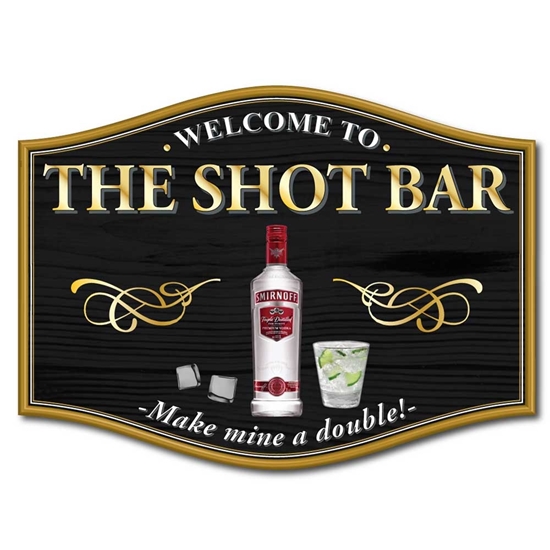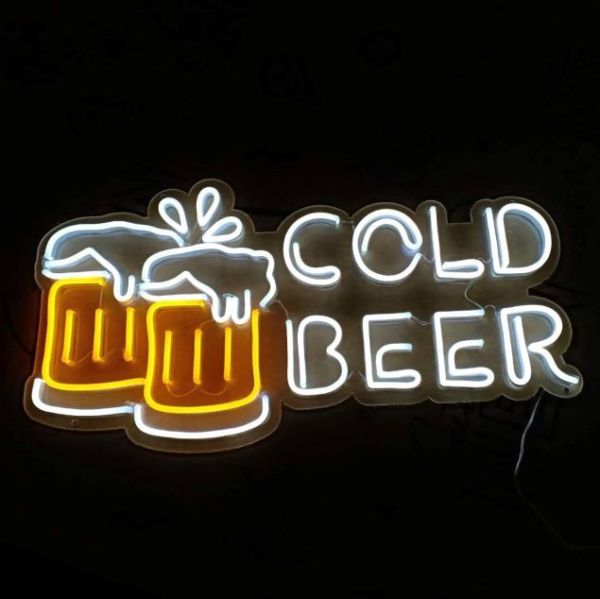Handy Ideas For Choosing Gin Bar Signs
Wiki Article
What Is The Difference Between The Sizes Of Bar Signs?
According to their intended use as well as their design aesthetics, location and the bar signs differ in their size. This is a brief overview of how the differences in size affect the function and aesthetics of bar signs: 1. Large Signs
Purpose: To serve as a focal point to draw attention.
Uses: Exterior branding, main brand signs or feature walls.
Placement: They are typically set up on walls or other large surfaces that are outside of the bar to draw customers.
Examples: large neon signs, vintage-style signs or mural-type signs.
2. Medium Signs
Uses: Give information or decorate the space without dominating.
They can be used for menu boards, as well as directions and displays for promotions.
Placement: Positioned to be easily spotted but not overpowering.
Examples: Metal signs that feature the logo of your bar, themed decorative signs, or medium-sized boards to advertise specials.
3. Small Signs
Purpose: Add subtle decorative elements or to offer specific details.
Table signs are used to indicate table settings as well as small decorative objects or labels.
Placement Furniture: shelves, tables or displays that permit close-up views.
Examples: Small framed quotes or drink cards.
Size Considerations
Visibility
Large signs are designed to draw attention of passers-by and establish the bar’s presence.
Medium signs are able to balance visibility and space efficiency to provide vital information without overpowering the decor.
Small Signs (small signs) They are perfect for intimate and close-up information that can be placed at eye level.
Proportion
Large Signs: They should be proportional to the size of the space to prevent overwhelming smaller areas. Great for open or large spaces.
Medium Signs: Ideal for interior use They can be put anywhere.
Small signs are great for adding details to tight areas and making them fit into smaller spaces without creating clutter.
Impact
Signs are bold and big. They make a statement. It is commonly employed to set the atmosphere for an establishment.
Medium Signs (Medium Size) Creates a balance between visual appeal and decor. Contributes to overall ambience while delivering important information.
Small Signs (Signs): Adds detail and charm to a visual experience.
Practicality
Due to their size, large signs could cost a lot.
Medium Signs offer greater flexibility in design and are easier to put up.
Small signs. Flexible, simple to change and update. Ideal for dynamic environments.
Functionality
Large Signs : Designed for visibility, attraction and the ability to function.
Medium Signs - They're both functional and stylish. They offer you vital information and also enhance your visual.
Small Signs: They are designed to give detailed information and support the subject in a subtle manner.
The ideal size of bar signage depends on their intended purpose, layout, and the desired effect on the patrons. Be sure to keep these aspects in mind so that the signs are contributing effectively to the ambience of the bar as well as its operational needs. Have a look at the top rated make a pub sign url for more info including novelty bar signs, pub signs to buy, the staying inn sign, staying inn sign, home pub signs, personalised outdoor bar signs, bar sign design, to the bar sign, garden bar signs, bar signs for garden and more.

Durability Is The Most Important Aspect In Determining The Bar's Endurance.
The durability of bar signs can vary in accordance with the material used the construction, location and material and also the intended usage. Here's how bar signs differ with respect to durability: 1. Material
Metal signs are resistant to rust and are durable, so they can be used in the outdoors.
Wood: Signs made of solid wood are durable, but they may require regular maintenance to avoid warping or rotting, particularly in outdoor settings.
Acrylic: Acrylic signs are lightweight and durable. They can also withstand exposure to outdoor elements.
The difference between LED and neon signs is the fact that neon signs can be brittle and easy to damage. However, LED signs are energy efficient and durable.
2. Weather Resistance
Outdoor Signs for the outdoors. Signs that are exposed outdoors to elements such as fading and rust require materials that are resistant to these effects.
Indoor Signs. Although indoor signs will not be exposed to extreme conditions, they should resist humidity, temperature fluctuations and wear.
3. Construction
Signs that have sturdy frames and corners that are reinforced are more durable.
Sealed Electrical Components: Signs that have sealed electrical components (for lit signs) are less prone to damage from water.
4. Maintenance Requirements
Low Maintenance Signs For bar owners who are busy signboards that require little maintenance like cleaning on occasion are the most practical.
High Maintenance Signs with intricate designs, delicate materials or special maintenance requirements are costly and time-consuming.
5. Location
Indoor Signs: Since indoor signs are usually less vulnerable to environmental hazards Their requirements for durability may be less than those for outdoor signs.
Outdoor Signs. Outdoor signs should be tougher to resist exposure to rain, sun and wind.
6. Impact Resistance
Signs that are designed for high-traffic locations or those that are susceptible to impacts (e.g. busy bars) must be constructed with tough materials that resist denting or scratches.
Signs that have laminated or protected surfaces are less likely to be damaged by scratches, spills or vandalism.
7. Longevity
Durability. Signs that last can last years and not deteriorate significantly, giving bar owners a great ROI on their investment.
Short-term Use: Signs for events or promotions that are temporary might not require the same durability as permanent signs.
8. Lighting
Lighting Components. Signs using Neon or LED lighting must have components that are durable and last for a long time.
9. Environmental Impact
Signs made out of recycled or sustainable materials could be more sustainable to the environment, while still providing durability and function.
10. Customization
Custom Options Signs which allow for personalization come with different levels of durability depending on their materials and manufacturing methods.
Durability is an asset.
Cost-Effectiveness: Durable signs require less frequent maintenance or replacement which reduces long-term costs.
Brand Image: Durable quality, high-quality signage will reflect positively on your bar's image and professionalism.
Customer Satisfaction signs well maintained contribute to an overall positive experience for the patron and improve the overall atmosphere of the bar.
When considering aspects such as the material, construction, and maintenance requirements, bar owners can choose signage options that provide the required durability to stand up to the demands of their surroundings and offer long-lasting value to their establishment. Have a look at the most popular her explanation about garden bar signs for site examples including personalised pub, bar sign design, pub signs made, staying inn sign, signs for garden bar, hanging bar sign, hanging home bar signs, home garden bar signs, home pub signs, bar signs and more.

What Is The Difference Between Bar Signs Found In Regulations As Well As Other Bar Signs?
The sign for bars is subjected to various rules and regulations, enforced by local as well as federal and state authorities, to ensure the health of the public, aesthetic standards, compliance with regulations on zoning, and to ensure public welfare. The regulations for bar signs differ. The size and position of bar signs are regulated.
Zoning law: This is a set of regulations that determine where signs may be placed in relation to their size, height and distances from property lines, road or other nearby structures.
Historical Districts. Signs of any size, designs, and materials can be banned to preserve the historic character.
2. Illumination Restrictions
Light Pollution: To minimize light pollution and preserve nighttime settings, laws may restrict the brightness of signs, their colors and their duration.
Safety considerations: Signs shouldn't cause glare that could cause distraction to pedestrians and drivers.
3. Content Signage
Alcohol Advertising: Alcohol advertising is prohibited in certain jurisdictions. This is a concern for images or content that could appeal to minors, or encourage excessive alcohol consumption.
Health Warnings: Some laws may require that signs include warnings about the dangers of alcohol or smoking.
4. Historic Preservation Regulations
Signs that are placed in historical districts must be in harmony with the architectural style of the district. This is often performed by preservation boards or commissions.
Materials and Design - Restrictions may be placed on the designs, materials or color schemes to ensure historical integrity.
5. Sign Permitting Process
Permits are needed: Owners of bars must get permits to set up or alter signage. This can require submitting drawings, and paying fees, as as obtaining approvals from local authorities.
Code Compliance - Signs must conform to building codes, regulations for safety in the event of fire, as well as standards of accessibility to ensure the safety and accessibility for people with disabilities.
6. Sign Removal Repair, Maintenance and Removal
Maintenance Requirements Owners of bars must keep signs in good shape, ensure they are structurally sound and free of any dangers. They must also be compliant with the regulations.
Abandoned sign: To prevent blight from the area and to ensure its aesthetic quality, regulations could determine the removal.
7. Digital Signage Regulations
Content Restrictions There are laws that govern the content of digital signs. They can prohibit certain types of content, like pictures that are offensive or flashing lights.
Limitations on Operationality Regulations could limit digital sign brightness and frequency, as well as motion. reduce visual obstructions.
8. Penalties and Enforcement
Inspections: Local authorities inspect signs periodically to make sure they're in compliance with the rules for signage. They issue citations when violations are found.
Penalties: Penalties if you do not follow the rules can include citations or fines for removal or alter signs, or legal action.
9. Signing Variance Process
Bar Owners can request a variance to allow them to break from the normal regulations for signs. The bar owner must justify their request and prove that the change will not cause negative effects on public safety.
Public Input: Certain issues may require public hearings, or input from residents, neighboring property owners, or business associations.
10. Community Input, Engagement and Engagement
Public Consultation - Certain communities include community members as part of the creation and the implementation of signage regulations through holding public meetings or surveys.
Community Benefits: Sign regulations can include provisions that improve the quality of signs or promote local businesses. It can help in the revitalization of neighborhoods.
Bar owners who know and follow signage regulations can ensure that their signage attract patrons, thereby benefitting their local community, and complying with legal standards. This can reduce the chance of legal disputes as well as penalties or fines. Follow the best garden bar signs for website advice including the staying inn sign, outdoor home bar signs, gin bar sign, pub signs to buy, to the bar sign, novelty bar signs, personalised home pub sign, modern pub sign, pub sign design ideas, to the bar sign and more.
